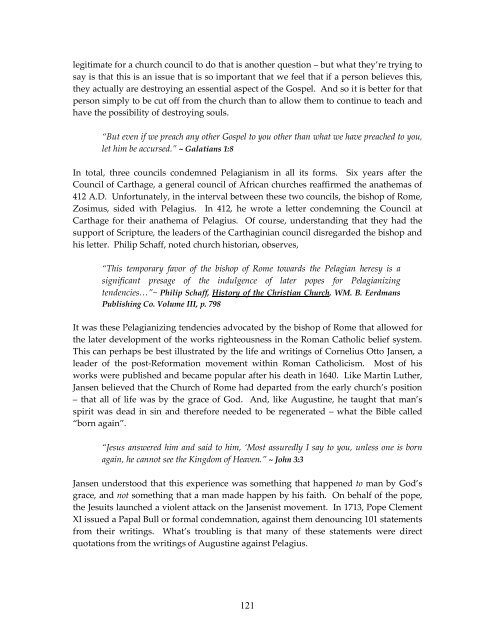AG STUDY GUIDE FINAL - The Forerunner
AG STUDY GUIDE FINAL - The Forerunner
AG STUDY GUIDE FINAL - The Forerunner
You also want an ePaper? Increase the reach of your titles
YUMPU automatically turns print PDFs into web optimized ePapers that Google loves.
legitimate for a church council to do that is another question – but what they’re trying to<br />
say is that this is an issue that is so important that we feel that if a person believes this,<br />
they actually are destroying an essential aspect of the Gospel. And so it is better for that<br />
person simply to be cut off from the church than to allow them to continue to teach and<br />
have the possibility of destroying souls.<br />
“But even if we preach any other Gospel to you other than what we have preached to you,<br />
let him be accursed.” ~ Galatians 1:8<br />
In total, three councils condemned Pelagianism in all its forms. Six years after the<br />
Council of Carthage, a general council of African churches reaffirmed the anathemas of<br />
412 A.D. Unfortunately, in the interval between these two councils, the bishop of Rome,<br />
Zosimus, sided with Pelagius. In 412, he wrote a letter condemning the Council at<br />
Carthage for their anathema of Pelagius. Of course, understanding that they had the<br />
support of Scripture, the leaders of the Carthaginian council disregarded the bishop and<br />
his letter. Philip Schaff, noted church historian, observes,<br />
“This temporary favor of the bishop of Rome towards the Pelagian heresy is a<br />
significant presage of the indulgence of later popes for Pelagianizing<br />
tendencies…”~ Philip Schaff, History of the Christian Church, WM. B. Eerdmans<br />
Publishing Co. Volume III, p. 798<br />
It was these Pelagianizing tendencies advocated by the bishop of Rome that allowed for<br />
the later development of the works righteousness in the Roman Catholic belief system.<br />
This can perhaps be best illustrated by the life and writings of Cornelius Otto Jansen, a<br />
leader of the post-Reformation movement within Roman Catholicism. Most of his<br />
works were published and became popular after his death in 1640. Like Martin Luther,<br />
Jansen believed that the Church of Rome had departed from the early church’s position<br />
– that all of life was by the grace of God. And, like Augustine, he taught that man’s<br />
spirit was dead in sin and therefore needed to be regenerated – what the Bible called<br />
“born again”.<br />
“Jesus answered him and said to him, ‘Most assuredly I say to you, unless one is born<br />
again, he cannot see the Kingdom of Heaven.” ~ John 3:3<br />
Jansen understood that this experience was something that happened to man by God’s<br />
grace, and not something that a man made happen by his faith. On behalf of the pope,<br />
the Jesuits launched a violent attack on the Jansenist movement. In 1713, Pope Clement<br />
XI issued a Papal Bull or formal condemnation, against them denouncing 101 statements<br />
from their writings. What’s troubling is that many of these statements were direct<br />
quotations from the writings of Augustine against Pelagius.<br />
121


